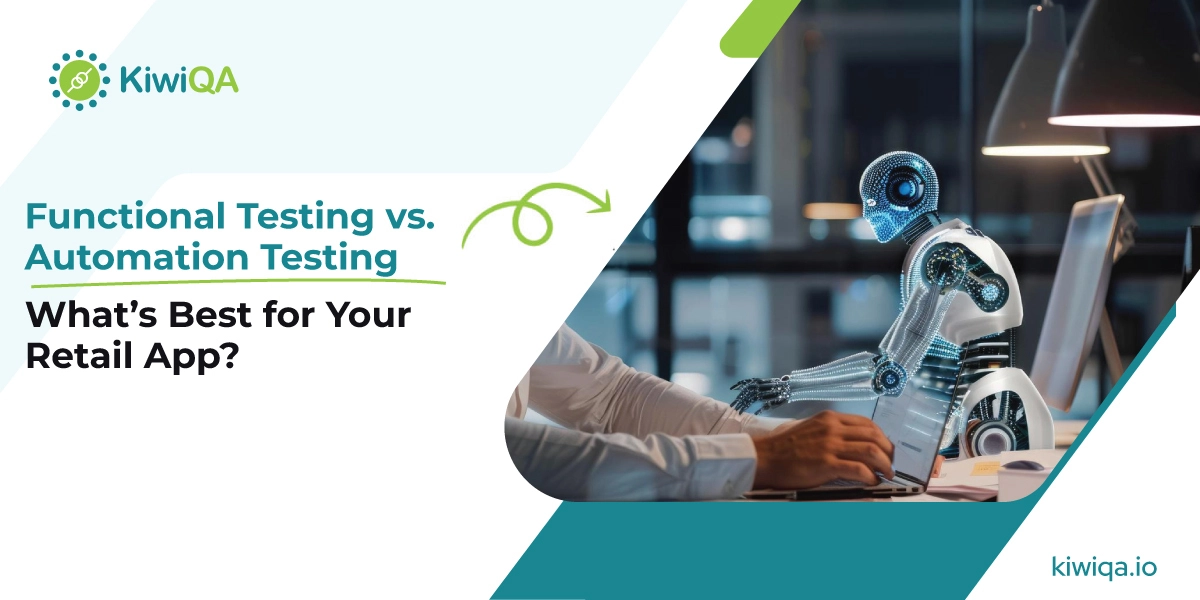Functional Testing vs. Automation Testing: What’s Best for Your Retail App?

 KiwiQA
KiwiQATable of Contents
Functional & automation testing are necessary aspects of testing retail software, each having distinct, unique benefits. Combining both the testing can enhance the testing quality and efficiency and minimize the testing costs. Based on the market research report, the global testing software industry will be a whopping $109.5 billion by 2027.
The retail industry has experienced an immense transformation because of changing user behavior. The retail industry has been adopting and embracing transformation. Software quality plays a crucial element in flourishing your retail business. This blog is all about comparing both testing methodologies and deciding which is best for retail applications. Before you consult with the experts in retail software testing services, read this blog.
Testing retail apps safeguards the application functionality, security, performance, etc. The following procedure ensures that the application can meet industry-specific requirements & adhere to high-quality standards. Retail application testing avoids this by checking the software variation. In this competitive world, where businesses are prioritizing customer satisfaction, retail app testing is necessary. Retail app testing smooths the journey to secure shopping, protect the brands, and develop loyal customers by removing all the glitches.
By using functional retail software testing in the retail industry, the retail app operates as desired scenarios like product searches, checkout methods, and account management.
Testing automation in the retail industry plays a strong role in avoiding customer information breaches. The automation testing team would focus on app profiling, encryption, and profiling to safeguard the retail app against threats. By utilizing automation testing, the team would introduce testing frameworks to improve security measures and mitigate sensitive data breach problems. Scroll down to learn more about functional testing vs automation testing.
The functional approach serves as the foundation for online and mobile apps. Organizations can attract and retain consumers for a longer amount of time by providing a fantastic design and smooth functionality.
So, in functional testing services, the capabilities and functioning of an application are examined to ensure user accessibility. Users instantly reject complicated applications, while testers guarantee that the program is accessible to everyone.
Unit testing verifies that every component’s code produces the expected results. Unit testing offers documentation of code development since each unit of code is extensively tested before advancing to the next one.
Integration testing evaluates whether separate software components work correctly together. Individual modules may have completed independent tests; however, if they rely on other modules to function properly, this type of testing is required to guarantee that all pieces work together as intended.
The following process of testing is performed to measure the integrated system adherence. System testing is performed by testers independently who were not involved in the program’s development. This testing is done in a setting that closely resembles production. System tests are critical because they ensure that the application fulfills the technical, functional, & customer criteria specified by the stakeholder.
UAT testing involves showing the software to real users in an operational environment. Feedback received from these actual users, who have no previous involvement with the program and may identify serious flaws in internal teams, is utilized to make additional adjustments to the product before its general launch.
It verifies the app is performing as intended and matches the project scope. The QA testing professionals check every element of the testing phase to ensure that, in the end, the result matches the business objectives. This can enhance program quality and help reduce malfunctions, mistakes, and security flaws.
Functional testing can assist in decreasing the likelihood of software failures, which may have serious consequences for the organization. Functional testing can assist in reducing these risks by detecting and correcting flaws early in the creation process.
Functional testing may be tedious, particularly for big or complicated software systems. This situation can further lead to affect project schedules and budgets.
Extensive project documentation is necessary to execute functional testing efficiently. This can be costly to set up and operate, and it may necessitate extra costs.
Also Read : 7 Challenges in Retail App Testing and How to Overcome Them
Automated testing is a testing approach that employs software tools and programs to do testing tasks. The automation testing market is also forecasting rapidly, and in the future, it will be forecasted to be $68 billion by the upcoming year 2025. This testing approach is quicker, more precise, and more dependable than manual testing. It saves the testing team a significant amount of effort and time while enhancing test quality and effectiveness. QA automation services are typically used for testing situations.
Unit tests are useful because they help to identify issues early in the development stage, lowering the cost of rectifying them. Unit testing is a valuable way for developers to understand the capabilities of each unit in the program and to encourage code reuse. Unit testing evaluates individual elements to measure the functionality.
API testing ensures that the application functions properly from beginning to end. Testers won’t be able to view the source code, and the procedure will not use keyboard inputs and outputs.
UI analysts examine the visual elements to measure their accuracy. These items must be presented appropriately and function properly to provide an improved user experience. UI retail software testing also ensures that the program can handle user actions. Its primary aim is to deliver streamlined UI & experience.
Performance testing evaluates software’s speed, security, and response under stress. The fundamental purpose of this sort of automated testing is to detect and remove any potential operational obstacles, allowing the software to work as effectively as possible and give the most meaningful benefits to the user. Performance retail app testing is an important part of assuring software success in marketplaces. It helps to discover any issues that clients may have later.
Automation testing identifies flaws more frequently than manual testing. Rapid bug discovery accelerates the whole developmental and testing process.
Automated testing may assist developers become more productive by automating operations that would otherwise be handled manually. Every time a new function or update is included in your application, you can set up your CI system to run and monitor the results of your automated tests.
It offers more reliable results, as tests are run regularly and automatically. Automated software testing enables you to quickly identify any flaws or regressions in the software, enabling you and your team to address such problems as they arise.
One of the major drawbacks of automated testing is that it takes a significant amount of time and money to implement. However, this investment is generally swiftly repaid in terms of increased developer efficiency and more consistent output.
Automation QA testers must be versatile, with an array of domain knowledge, technological experience, and testing abilities that enable them to provide high-quality software rapidly.
When comparing functional testing vs automation testing, Functional testing offers a detailed verification of whether the app is functioning well on every platform, device, and OS. Automation testing is required for broad & best for repetitive tasks.
Testing is a key to verifying the reliability and quality of the application. In functional testing, higher ongoing manual effort is required, whereas automation testing requires high initial costs & lower ongoing efforts. Automation retail testing services deliver scalable solutions as compared to manual testing.
Comparing functional testing vs automation testing in terms of speed & efficiency, functional testing is slower because of its manual nature. Functional testing verifies that the software matches the user’s expectations & follows all the needs. The automated testing delivers consistency and reliability & can be integrated into the continuous testing pipelines.
When comparing functional retail software testing with automation testing, in terms of flexibility & adaptability, Functional Testing is more flexible & adapts to change rapidly, whereas automation testing is less flexible and requires updated scripts for changes.
Having software capable of quickly adapting to the new requirement is necessary. Responsiveness and flexibility of application are key. Comparing Functional and Automation Testing in Retail Software, Test automation allows the reconfiguring of the quick test & limits the time spent on rectifying the modifications.
When you look for retail testing services, understand the application size & complexity. Measure testing to project objectives to acknowledge project variability and encourage a versatile and adaptable testing strategy. This leads to more relevant and effective testing activities. The complexity & the size of your retail app play a key role in deciding which testing should be done. The complex and larger applications benefit from more automation.
Before you pick any testing methodology like functional testing vs automation testing for Retail Platforms, decide the development cycle and the time constraints. Shorter cycles may require automation testing.
A realistic and detailed budget and timescale for your project to develop & test retail mobile apps are essential since they can assist you in preventing common issues, such as overpaying, minimizing, and missing deadlines. The cost and timeline are estimations and allocations for your app resources for development, which include human, financial, and technological resources. To plan your budget and timescale, you must consider a variety of factors that might affect app development & testing costs and deadlines, such as the complexity, dimension, and standard of your app, the platform and technology you choose, and the size and competency of your team.
Also Read : How to Conduct Effective Performance Testing on Retail Apps?
To follow the right approach for testing retail mobile apps, first, you should consult with skilled QA testers. Look for a testing company that has skilled & professional testers with extensive knowledge of manual & automated testing. Choose testing companies that are investing in improving their team’s abilities and training in automated testing. Choose a QA team that stays updated on the newest automation testing trends, innovations, and technologies. Renowned testing companies always offer the teams the resources they need to improve their domain skills even further. Start with the testing methodologies in which your selected testing experts specialize.
The combination of functional and automated testing gives instant feedback and the capacity to swiftly react to changing surroundings and testing scenarios. Functional testing allows for verifying the functions of applications, whereas automation assures consistency and dependability in recurring operations.
The most successful functional testing methodologies combine both scripted and exploratory approaches. Scripted tests guarantee that essential pathways and popular use cases are regularly covered, whereas exploratory testing allows for in-depth research and innovative issue-solving.
Automation regression testing is the process of evaluating a software product or application utilizing automated tools and methodologies following an update or modification to the product. The automation process employs scripted tests, operations, and other procedures from a regression testing methodology.
After concluding the above-described things, you now understand functional & automated testing along with their benefits. We have discussed both testing methodologies briefly and created a brief comparison. Now it’s your turn to decide which retail software testing services to choose for testing your retail app. Make sure your choice should be according to individual project scope. Always make an informative decision to maximize the coverage & efficiency.
Join the like-minded community & get the latest updates and insights on software testing technological transformation around the globe. Don't miss out.
